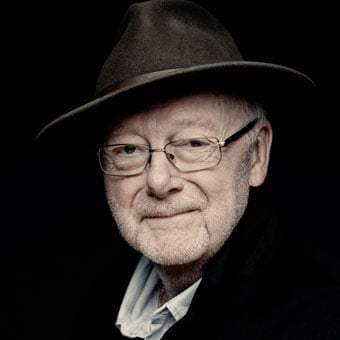
Louis Andriessen
Eine Einführung in die Musik Louis Andriessens
von Elmer Schönberger
Mit zwanzig Jahren gab es bei Louis Andriessen in Nocturnen bereits Anzeichen frankophiler Interessen, für die seine Familie, eine Komponistendynastie, bekannt war. In den Folgejahren gab er mit diversen Ittrospezioni einen eigensinnigen Kommentar zu seinen Erfahrungen in der Schönen Neuen Welt von Reihe und Ratio ab, erhob in dem Stückepaar Anachronie Stillosigkeit zum Stil und entwarf in Contra tempus einen Plan für seine musikalische Zukunft. Erst 1976 mit De Staat drückte Andriessen jedoch der Nachkriegsmusik in Europa seinen unauslöschlichen Stempel auf. De Staat bezeichnete nicht nur die Geburt dessen, was seither als der "wahre" Louis Andriessen gilt, sondern führte auch einen Bruch herbei, der die holländische Musik in "Prä-" und "Post-" unterteilte. Vieles von dem, was seither als "typisch holländische Musik" gilt, kann auf diese erregende, unmittelbar wiedererkennbare Kombination aus Klavieren, Harfen, Blasinstrumenten, Baßgitarren und in enger Lage behandelten Vokalgruppen zurückgeführt werden, diese Kombination aus Bravour und Monumentalität, aus Förmlichkeit und Spontaneität sowie aus amerikanischem Minimalismus und holländischer Bodenständigkeit, die De Staat seine ureigene Klangqualität und Dynamik verleiht.
Alle diese Besonderheiten einschließlich der Anwendung von Verfahren der prozessualen Musik, des einprägsamen melodischen und harmonischen Materials und der kontrastreichen Kettenformen, stellen den Ausgangspunkt einer Suche dar, die den Komponisten in die entlegensten Regionen musikalischer und außermusikalischer Thematik geführt hat, von De Tijd (Die Zeit) bis De Snelheid (Die Geschwindigkeit) und von De Materie bis TAO (Der Weg). Die Thematisierung solcher Allgemeinbegriffe brachte ständig neue kompositorische Blickwinkel hervor – neue Musik "um" diese Begriffe, wie es Andriessen gern selbst formuliert. Das typische Andriessen-Werk ist eine an philosophischer Neugier reiche Komposition, deren Identität in den sich stetig ändernden, aber immer ausgeprägten Entscheidungen im Bereich von Struktur und Material entsteht, ebenso wie im Wechselspiel zwischen spekulativem Konstruktivismus und instinktivem Empirismus.
Dabei ist Andriessens Oeuvre alles andere als einförmig. Im Gegenteil, es umfaßt zahlreiche Gattungen, nimmt das Leichtgewichtige so ernst wie das Tiefgründige und ist auf unmodernistische Art großzügig, wenn es darum geht, seine Nähe zu anderen musikalischen Einflüssen zuzugeben, ob es sich bei diesem "Anderen" um Stravinsky oder Charlie Parker, um Bach oder Ives, um Boogie-Woogie oder Rap handeln mag. Diese Aufgeschlossenheit kombiniert mit strenger Disziplin machen Andriessen zu einem gefragten Lehrer mit wesentlichem Einfluß auf die Komponistengeneration, der unter anderem Steve Martland, David Lang, Julia Wolfe und Cornelis de Bondt angehören.
Andriessens Kompositionen manövrieren zwischen den Extremen einer ungestümen Rhetorik und reiner, zeitloser Schönheit, zwischen schneller, lauter, extrovertierter Musik wie in De Stijl und bedächtiger, gedämpfter, nachdenklicher Musik wie in Hadewijch, zwischen großangelegtem Musiktheater wie in Rosa und bescheiden konzipierter Theatermusik wie in Dances. All dies ist in einem besonders mannigfaltigen Instrumentationsspektrum angesiedelt, das vom Bläserensemble (in Symphonies of the Netherlands, einem unbeschwerten Miniatur-De Staat) bis zum eleganten Cembalo in Overture to Orpheus reicht.
Die Tatsache, daß die traditionelle sinfonische Besetzung in seinem Oeuvre fehlt, ist eine direkte Folgeerscheinung seines kategorischen politischen Standpunkts in den siebziger Jahren. Andriessens einzige "Sinfonie" ist ein Werk mit eingebautem Handikap: die Symfonie voor losse snaren – eine Sinfonie für vorsätzlich umgestimmte leere Saiten. Die bewußte Entscheidung, dem Sinfonieorchester den Rücken zu kehren und – durch Gründung von Gruppen wie Hoketus und dem nach wie vor aktiven De Volharding – sich dem individuellen Klang selbst zusammengestellter Ensembles zuzuwenden, ließ den typisch Andriessenschen Klang entstehen, und auf die gleiche Weise nahm das Ideal einer demokratisierten Musikpraxis in der virtuosen Homophonie von De Staat mit seinen Akkordblöcken und messerscharfes Spiel erfordernden Unisonomelodien Gestalt an.
Musikalische Innovation ist politisch gefährlich, singt – mit Bezug auf Plato – ein Quartett aus Frauenstimmen im Brechtartigen Lehrstück, das Andriessens eigene Politeia, De Staat, auch ist. Sich Brecht zum Modell nehmend, benutzt De Staat es als Beispiel, um es zu widerlegen. Wenn es nur so wäre! Wenn Plato nur recht gehabt hätte, ruft die Musik, nicht im gesungenen griechischen Text, sondern in den aufrichtig empfundenen Klängen selbst, in denen die Worte untergehen. Es ist eine idealistische Botschaft, die Louis Andriessens Musik – und sei es auch nur zwischen den Notenzeilen – ständig und in unzähligen verschiedenen Formen und Aufmachungen bis weit über The Last Day (Den Letzten Tag) hinaus wiederholt.
Elmer Schönberger, 1998
(Musikwissenschaftler, Autor, Komponist und zusammen mit Andriessen Verfasser der Stravinsky-Studie The Apollonian Clockwork.)
